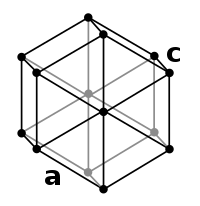
Photo from wikipedia
Electrochemical water splitting via a cathodic hydrogen evolution reaction (HER) is an advanced technology for clean H2 generation. Ru nanoparticle is a promising candidate for the state-of-the-art Pt catalyst; however,… Click to show full abstract
Electrochemical water splitting via a cathodic hydrogen evolution reaction (HER) is an advanced technology for clean H2 generation. Ru nanoparticle is a promising candidate for the state-of-the-art Pt catalyst; however, they still lack the competitiveness of Pt in alkaline and neutral media. Herein, a ternary HER electrocatalyst involving nano Ru and Cr2O3 as well as N-doped graphene (NG) that can work in alkaline and neutral media is proposed. Cr2O3 and NG feature strong binding energies for hydroxyl and hydrogen, respectively, which can accelerate the dissociation of water, whereas Ru has weak hydrogen binding energy to stimulate hydrogen coupling. The HER activity of Ru is greatly enhanced by the promoted water-dissociation effect of NG and Cr2O3. To achieve a current density of 10 mA cm−2, the as-obtained Ru–Cr2O3/NG only needs a very low overpotential of 47 mV, which outperforms the activity of Pt/C in alkaline media. The strategy proposed here, multi-site acceleration of water dissociation, provides new guidance on the design of a highly efficient, inexpensive, and biocompatible HER catalyst in nonacidic condition.
Journal Title: RSC Advances
Year Published: 2021
Link to full text (if available)
Share on Social Media: Sign Up to like & get
recommendations!